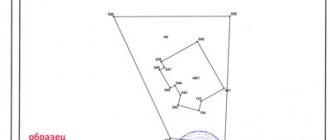Home / Real estate / Land / Land surveying
Back
Published: 03/05/2017
Reading time: 7 min
0
517
Starting from the new year 2020, in order to carry out various transactions with plots of land, it is necessary to carry out boundary surveys.
In our article we will describe in detail the legislative norms in the field of land surveying, and also tell you what needs to be done if your neighbor refuses to sign the necessary documents and in what cases boundary surveying is carried out without the consent of the neighbors.
Land surveying - determining the boundaries of a land plot in a certain area.
Boundaries are fixed based on the installation of special boundary signs and are recorded in the boundary plan of the land plot.
It is important to be able to distinguish between cadastral work with a plot of land and boundary surveying, despite the fact that these concepts are related, in fact they differ from each other. Cadastral activities are carried out to record real estate and land in the state, while land surveying is part of cadastral work with a site and comes down to determining the boundaries of the site, its actual area and location.
Surveying the boundaries of a land plot in the Russian Federation is permitted only to experienced and certified specialists
- cadastral engineers.
Therefore, to carry out legal land surveying, you will, one way or another, have to turn to educated specialists. Do not forget that the foundations of land surveying, which are laid down by law, are common to all regions of the Russian Federation; in each individual district, city or region, land surveying may differ depending on local regulations, therefore, turning to cadastral engineers for help is important Also review the laws in your area.
- Legislative norms
- In what cases is land survey coordination with neighbors not required?
- What to do if a neighbor interferes with boundary surveying?
Notifying neighbors
In relation to undemarcated lands, the owner does not have the right to perform legally significant actions - sell, donate, lease.
Therefore, the owner needs to carry out land surveying and determine the boundaries of the territory. To do this, you should contact a specialized company engaged in land work. To conclude an agreement, you will need a passport of the owner of the land and title documents for the allotment. The owner of the site is obliged to notify in writing other interested parties, that is, the owners of adjacent territories, about the upcoming land surveying work. In this case, the notice period must be at least one month before the date of the planned work.
From the moment the notification is received, the interested party may object to the upcoming work. If no written objections are received, then the notification is considered valid.
Neighbors must be present when land surveying is carried out and can express their disagreement with the work carried out in writing. If interested parties, duly notified, do not appear for the survey, then the work will be carried out in their absence.
What is included in the notice
According to paragraph 9 of Art. 39 of Federal Law No. 221-FZ of July 24, 2007, the notification contains the following information:
- information about the customer and cadastral engineer;
- address and cadastral number of the territory;
- procedure for familiarizing yourself with the draft boundary plan;
- date, time and place of survey;
- the address to which interested parties can send their objections.
If one of the neighbors refuses to accept a notice issued in the prescribed manner, then such person is considered to have been properly notified.
How is land surveying carried out?
Cadastral work takes place in the following sequence:
- Conclusion of an agreement.
- Collection of information about the site.
- Notification of interested parties.
- Departure to the territory for inspection.
- Preparation and signing of an act of approval of boundaries with all owners of adjacent plots.
- Execution of graphic drawing.
- Drawing up a boundary plan.
Boundary approval acts are a mandatory appendix to the boundary plan. Based on these documents, the land is registered in the cadastral register.
During the execution of boundary work on the customer’s territory, the cadastral engineer explains to all owners the measurements taken and the accuracy of their implementation. Owners of adjacent territories must read this information and sign an agreement.
The signing of the act confirms that all interested parties agree with the calculations made. If relations with neighbors are good, then work can be carried out in their absence by prior agreement. The main condition for this is the subsequent signing of the act.
The land surveying procedure is considered legal and competent only if the act of boundary approval is signed by all owners of adjacent plots.
Reasons for neighbor's disagreement
A neighbor may refuse to sign the act both for subjective reasons, for example, personal hostility, and for completely objective reasons:
- incorrect determination of the coordinates of turning points;
- crossing or overlapping the boundaries of adjacent lands;
- errors in documents caused by human factors;
- contradictions between previously issued documents and newly received measurements;
- unauthorized seizure of part of someone else's land.
Disputed boundaries of territories can be a consequence of both the mistakes of surveyors who previously carried out measuring work, and the imperfection of legislation. Previously, cadastral work was not mandatory for cadastral registration. In addition, modern equipment, with the help of which the boundaries and area of territories are determined, is more accurate than the instruments used 10 or 20 years ago.
If a neighbor has a reasonable disagreement with the work carried out and the establishment of new boundaries of the territories, then he has the right to submit them in writing.
In accordance with paragraph 4 of Art. 40 of Federal Law No. 221, the cadastral engineer must make entries in the boundary approval act about any objections from interested parties. The written objections themselves are attached to the boundary plan and are an integral part of it.
How to coordinate the boundaries of a plot if the neighbor is unknown
The frequent practice of determining the boundaries of a land property without the participation of the owner of the adjacent territory is due to the impossibility of establishing the location of such a person, for example, if the adjacent plot has been abandoned for a long time or it is not possible to identify the owner.
In this case, in accordance with the established regulations, the initiator is obliged to place an announcement on the pages of local media about the intention to carry out the procedure for approving the boundaries of adjacent areas.
If, after a month from the date of publication of such an announcement, the owner does not show up, the cadastral engineer will carry out the work without his participation in the presence of the interested person.
Where should the owner of the plot contact if the neighbor does not sign the deed?
Having read the written objections of interested parties, the owner first of all needs to try to peacefully resolve the conflict situation. To do this, you can look up archival information about the history of the plot, compare your neighbor’s cadastral passport with the newly obtained data based on the results of the land survey, and try to prove your case with documents.
If nothing works, and the neighbor still claims part of the adjacent territory, then you need to contact a special land management committee under Rosreestr. The controlling body will carry out the necessary measuring procedures and determine the correctness of the land survey by the cadastral engineer.
The next step is to file a complaint with the prosecutor's office. The complaint states that the neighbor is violating the rights to use the land or has illegally taken possession of part of the plot.
The final authority to resolve a dispute regarding the boundaries of a property is the court. The judicial authority will not force the interested person to sign the act of coordinating boundaries. But, having considered all the materials and arguments of both sides, the court will establish the boundaries of the territory. The land will be registered with Rosreestr based on a court order.
Act of approval of the boundaries of a land plot
An integral part of the land management project is the act of agreeing on the boundaries of the land plot. This documentation is drawn up in case of privatization, lease, change in the intended purpose of land, allocation of territories for construction, etc. The document is signed by the entity registering the right to the land, as well as by the owners and users of neighboring territories, reports.
What is an act of approval of the boundaries of a land plot?
The act of agreeing on the boundaries of a land plot traditionally acts as the result of a procedure designed to establish the location of the boundaries of a land territory. Such a document is a necessary link in the implementation of cadastral work on the formation of land plots and in clarifying the size of the plot.
An act of approval of the boundaries of a land plot is a document confirming the absence of claims on the part of the right holders of neighboring lands to establish the boundaries of the allocated territory. The signing of the act by the owners and land users of adjacent plots means that they agree with the location and contours of the allocated territory.
The act confirms the agreement of boundary signs in relation to the formed plot between the subjects of land relations. Without this document, neither a private individual nor a developer will be able to legally register land rights, which is one of the key points in construction. Therefore, when registering land rights for a new building, it is impossible to do without obtaining the consent of third parties.
Coordination of boundaries is carried out as part of a cadastral survey - a study of a site with the establishment of its boundaries, size, location, etc. The signed act is attached to the technical documentation of land management for establishing boundaries in kind (on the ground).
Use the consultation:
When is an act of approval of the boundaries of a land plot drawn up?
Coordination of the boundaries of a land plot is carried out in the case of cadastral survey, which is necessary in the following cases:
privatization of land or transfer for use;
allocation of land for construction;
change of purpose of the territory;
division of land into two or more plots, etc.
A set of cadastral survey works is carried out both if it is necessary to establish boundaries on a new site, and in the event of their restoration in an area that previously had boundary signs. The issue of coordinating boundaries with neighbors is usually dealt with by a company that develops land management documentation. She organizes a meeting with the persons who must sign the act.
Take advantage of the consultation:
How to obtain an act of approval of the boundaries of a land plot
The act of approving the boundaries of a land plot is drawn up by a licensed organization during the development of land management documentation. Certified surveying engineers, who must be in the company developing the land development project, determine the boundaries, dimensions, configuration, area, location and other parameters of the land plot. The procedure is performed directly on site using special equipment. Upon completion of geodetic work, an act is drawn up, which is signed by the owners and land users of adjacent plots. The performer of the work secures the boundaries of the site with boundary signs, which are installed in kind in the presence of the parties signing the act.
These works are part of the creation of documentation for the allocation of land. Without them, it is impossible to coordinate the project with the State GeoCadastre, architecture and urban planning authorities, etc. Accordingly, it will no longer be possible to register the right to use or own the site.
If a neighbor refuses to sign the boundary agreement act
Often, when drawing up an act of approval of the boundaries of a land plot, one has to face difficulties when it is not possible to obtain the signature of the owner or user of the adjacent territory. Common situations:
the owner or tenant of the land does not give consent for personal reasons;
there is no way to obtain the subject's signature due to his absence.
In any of these cases, there are two ways to solve the problem: through local governments or through the courts.
Contact local authorities
According to Article 158 of the Land Code, disputes regarding land issues have the right to be resolved by local government bodies. Therefore, if the owner or tenant of a neighboring territory refuses to sign the act, you can submit a corresponding application to the city or village council. The authorities will appoint a commission that will inspect the site, after which it will hold a meeting with the participation of the parties to the dispute.
Having proven the groundless refusal to sign the act, the commission recommends that the parties resolve the conflict peacefully. The minutes of the meeting are attached to the land management documentation. If signing a document is impossible due to the absence of the subject of land legal relations, the commission makes a decision to agree on boundaries without the participation of this party. If, on the recommendation of local authorities, the owner or land user of a neighboring plot refuses to sign the act of coordinating boundaries, you will have to move on to the second method of resolving the conflict - through the court.
Take advantage of the consultation:
Go to court
According to the Land Code, subjects of land legal relations must observe good neighborliness and not violate the rights of owners and land users of neighboring land plots. An unfounded refusal to sign a border approval act is qualified by the court as an illegal action that prevents a person from freely disposing of the land allotted to him. Therefore, if the dispute is resolved in favor of the plaintiff, the act will be forced to be signed or the approval of boundaries will be confirmed without the signature of the relevant party.
Thus, first you should try to resolve the conflict peacefully by reaching an agreement with your neighbor without outside help. If negotiations are unsuccessful, contact the City Council, but in this case, even if a decision is made in your favor, no one will force anyone to sign the act. Local authorities only recommend to the parties the optimal way to solve the problem. If the land user or owner still insists on his own and does not sign the document, he will have to defend his rights through the court.
Photo: DOM.RIA™ - all real estate in Ukraine. Sales and rentals - RIA.com











